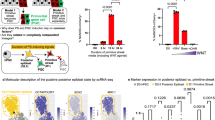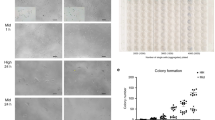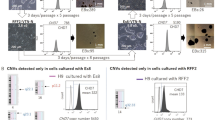Abstract
Human embryonic stem cell (hESC) lines are known to be morphologically and phenotypically heterogeneous. The functional nature and relationship of cells residing within hESC cultures, however, has not been evaluated because isolation of single hESCs is limited to drug or manual selection. Here we provide a quantitative method using flow cytometry to isolate and clonally expand hESCs based on undifferentiated markers, alone or in combination with a fluorescent reporter. This method allowed for isolation of stage-specific embryonic antigen-3–positive (SSEA-3+) and SSEA-3− cells from hESC cultures. Although both SSEA-3+ and SSEA-3− cells could initiate pluripotent hESC cultures, we show that they possess distinct cell-cycle properties, clonogenic capacity and expression of ESC transcription factors. Our study provides formal evidence for heterogeneity among self-renewing pluripotent hESCs, illustrating that this isolation technique will be instrumental in further dissecting the biology of hESC lines.
This is a preview of subscription content, access via your institution
Access options
Subscribe to this journal
Receive 12 print issues and online access
$259.00 per year
only $21.58 per issue
Buy this article
- Purchase on Springer Link
- Instant access to full article PDF
Prices may be subject to local taxes which are calculated during checkout





Similar content being viewed by others
References
Thomson, J.A. et al. Embryonic stem cell lines derived from human blastocysts. Science 282, 1145–1147 (1998).
Amit, M. et al. Clonally derived human embryonic stem cell lines maintain pluripotency and proliferative potential for prolonged periods of culture. Dev. Biol. 227, 271–278 (2000).
Genbacev, O. et al. Serum-free derivation of human embryonic stem cell lines on human placental fibroblast feeders. Fertil. Steril. 83, 1517–1529 (2005).
Lee, J.B. et al. Establishment and maintenance of human embryonic stem cell lines on human feeder cells derived from uterine endometrium under serum-free condition. Biol. Reprod. 72, 42–49 (2005).
Xu, C. et al. Immortalized fibroblast-like cells derived from human embryonic stem cells support undifferentiated cell growth. Stem Cells 22, 972–980 (2004).
Stojkovic, P. et al. An autogeneic feeder cell system that efficiently supports growth of undifferentiated human embryonic stem cells. Stem Cells 23, 306–314 (2005).
Wang, Q. et al. Derivation and growing human embryonic stem cells on feeders derived from themselves. Stem Cells 23, 1221–1227 (2005).
Lee, J.B. et al. Available human feeder cells for the maintenance of human embryonic stem cells. Reproduction 128, 727–735 (2004).
Yoo, S.J. et al. Efficient culture system for human embryonic stem cells using autologous human embryonic stem cell-derived feeder cells. Exp. Mol. Med. 37, 399–407 (2005).
Xu, C. et al. Feeder-free growth of undifferentiated human embryonic stem cells. Nat. Biotechnol. 19, 971–974 (2001).
Li, Y., Powell, S., Brunette, E., Lebkowski, J. & Mandalam, R. Expansion of human embryonic stem cells in defined serum-free medium devoid of animal-derived products. Biotechnol. Bioeng. 91, 688–698 (2005).
Amit, M., Shariki, C., Margulets, V. & Itskovitz-Eldor, J. Feeder layer- and serum-free culture of human embryonic stem cells. Biol. Reprod. 70, 837–845 (2004).
Ma, Y., Ramezani, A., Lewis, R., Hawley, R.G. & Thomson, J.A. High-level sustained transgene expression in human embryonic stem cells using lentiviral vectors. Stem Cells 21, 111–117 (2003).
Costa, M. et al. The hESC line Envy expresses high levels of GFP in all differentiated progeny. Nat. Methods 2, 259–260 (2005).
Vallier, L. et al. Enhancing and diminishing gene function in human embryonic stem cells. Stem Cells 22, 2–11 (2004).
Carpenter, M.K. et al. Properties of four human embryonic stem cell lines maintained in a feeder-free culture system. Dev. Dyn. 229, 243–258 (2004).
Mazurier, F., Gan, O.I., McKenzie, J.L., Doedens, M. & Dick, J.E. Lentivector-mediated clonal tracking reveals intrinsic heterogeneity in the human hematopoietic stem cell compartment and culture-induced stem cell impairment. Blood 103, 545–552 (2004).
Evans, M.J. & Kaufman, M.H. Establishment in culture of pluripotential cells from mouse embryos. Nature 292, 154–156 (1981).
Hope, K.J., Jin, L. & Dick, J.E. Acute myeloid leukemia originates from a hierarchy of leukemic stem cell classes that differ in self-renewal capacity. Nat. Immunol. 5, 738–743 (2004).
Enver, T. et al. Cellular differentiation hierarchies in normal and culture-adapted human embryonic stem cells. Hum. Mol. Genet. 14, 3129–3140 (2005).
Kannagi, R. et al. Stage-specific embryonic antigens (SSEA-3 and -4) are epitopes of a unique globo-series ganglioside isolated from human teratocarcinoma cells. EMBO J. 2, 2355–2361 (1983).
Draper, J.S., Pigott, C., Thomson, J.A. & Andrews, P.W. Surface antigens of human embryonic stem cells: changes upon differentiation in culture. J. Anat. 200, 249–258 (2002).
Dean, P.N. & Jett, J.H. Mathematical analysis of DNA distributions derived from flow microfluorometry. J. Cell Biol. 60, 523–527 (1974).
Fox, M.H. A model for the computer analysis of synchronous DNA distributions obtained by flow cytometry. Cytometry 1, 71–77 (1980).
Martin, G.R. & Evans, M.J. The morphology and growth of a pluripotent teratocarcinoma cell line and its derivatives in tissue culture. Cell 2, 163–172 (1974).
Sato, N., Meijer, L., Skaltsounis, L., Greengard, P. & Brivanlou, A.H. Maintenance of pluripotency in human and mouse embryonic stem cells through activation of Wnt signaling by a pharmacological GSK-3-specific inhibitor. Nat. Med. 10, 55–63 (2004).
Reubinoff, B.E., Pera, M.F., Fong, C.Y., Trounson, A. & Bongso, A. Embryonic stem cell lines from human blastocysts: somatic differentiation in vitro. Nat. Biotechnol. 18, 399–404 (2000).
Rosler, E.S. et al. Long-term culture of human embryonic stem cells in feeder-free conditions. Dev. Dyn. 229, 259–274 (2004).
Eiges, R. et al. Establishment of human embryonic stem cell-transfected clones carrying a marker for undifferentiated cells. Curr. Biol. 11, 514–518 (2001).
Andrews, P.W. et al. A pluripotent human stem-cell clone isolated from the TERA-2 teratocarcinoma line lacks antigens SSEA-3 and SSEA-4 in vitro, but expresses these antigens when grown as a xenograft tumor. Differentiation 29, 127–135 (1985).
Chadwick, K. et al. Cytokines and BMP-4 promote hematopoietic differentiation of human embryonic stem cells. Blood 102, 906–915 (2003).
Wang, L., Li, L., Menendez, P., Cerdan, C. & Bhatia, M. Human embryonic stem cells maintained in the absence of mouse embryonic fibroblasts or conditioned media are capable of hematopoietic development. Blood 105, 4598–4603 (2005).
Acknowledgements
We acknowledge R. Mondeh, A. Rouleau and J. Yang for outstanding technical assistance, and D. Sheerar for cell isolation. We thank K. Vijayaragavan for critical review of the manuscript. This research was funded by a grant from the Canadian Institutes of Health Research (CIHR) and the National Centres of Excellence–Stem Cell Network Program and postgraduate scholarship award from the Stem Cell Network to M.H.S., and CIHR Canadian Graduate Scholarships to S.C.B. and K.C.
Author information
Authors and Affiliations
Contributions
M.H.S. performed experiments and assisted in writing the paper; M.B., K.C., P.M. and S.C.B. assisted with experiments; M.B. wrote and edited the paper.
Corresponding author
Ethics declarations
Competing interests
The authors declare no competing financial interests.
Supplementary information
Supplementary Fig. 1
Feeder-free hESC cultures are heterogeneous. (PDF 939 kb)
Supplementary Fig. 2
Irradiated hdFs allow for hESC culture regeneration from FACS isolated hESC populations. (PDF 592 kb)
Supplementary Fig. 3
eGFP and DsRed Lentiviral vectors. (PDF 257 kb)
Supplementary Fig. 4
Sorted hESC cultures retain pluripotency demonstrated by in vivo differentiation. (PDF 1832 kb)
Supplementary Fig. 5
hESC cultures regenerated from sorted hESC populations are karyotypically normal. (PDF 452 kb)
Supplementary Fig. 6
Unlike sorted SSEA-3- cells derived from hESC cultures (Figure 5b) hdFs do not express mRNA for POU5F1 or NANOG. (PDF 324 kb)
Supplementary Protocol 1
Generation of hESC derived fibroblast-like cell (hdF) cultures. (PDF 181 kb)
Supplementary Protocol 2
Sorting of feeder free hESCs and regeneration of sorted hESC cultures. (PDF 125 kb)
Rights and permissions
About this article
Cite this article
Stewart, M., Bossé, M., Chadwick, K. et al. Clonal isolation of hESCs reveals heterogeneity within the pluripotent stem cell compartment. Nat Methods 3, 807–815 (2006). https://doi.org/10.1038/nmeth939
Received:
Accepted:
Published:
Issue Date:
DOI: https://doi.org/10.1038/nmeth939
This article is cited by
-
ZBTB12 is a molecular barrier to dedifferentiation in human pluripotent stem cells
Nature Communications (2023)
-
Reprogramming mechanisms influence the maturation of hematopoietic progenitors from human pluripotent stem cells
Cell Death & Disease (2018)
-
Automated adherent cell elimination by a high-speed laser mediated by a light-responsive polymer
Communications Biology (2018)
-
Homogeneity evaluation of mesenchymal stem cells based on electrotaxis analysis
Scientific Reports (2017)
-
Revisiting Mitochondrial Function and Metabolism in Pluripotent Stem Cells: Where Do We Stand in Neurological Diseases?
Molecular Neurobiology (2017)



